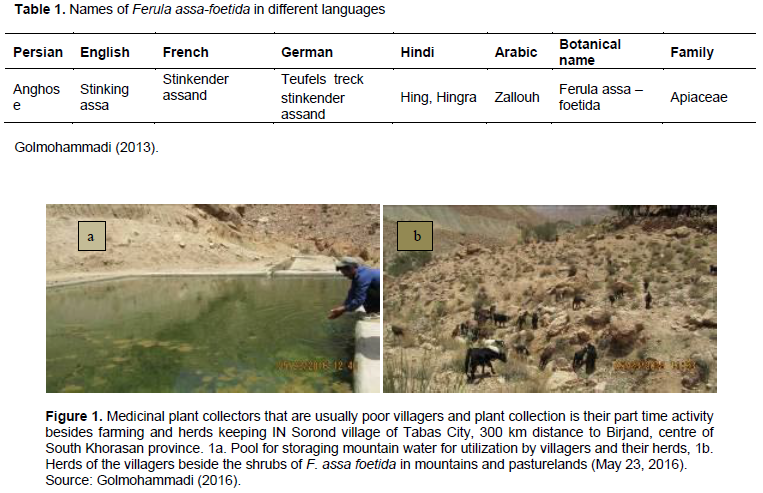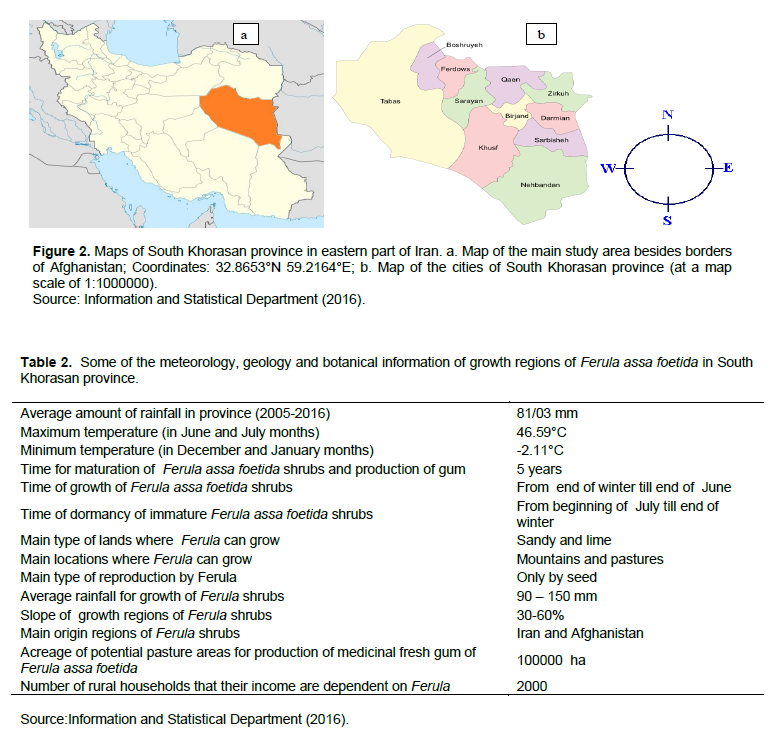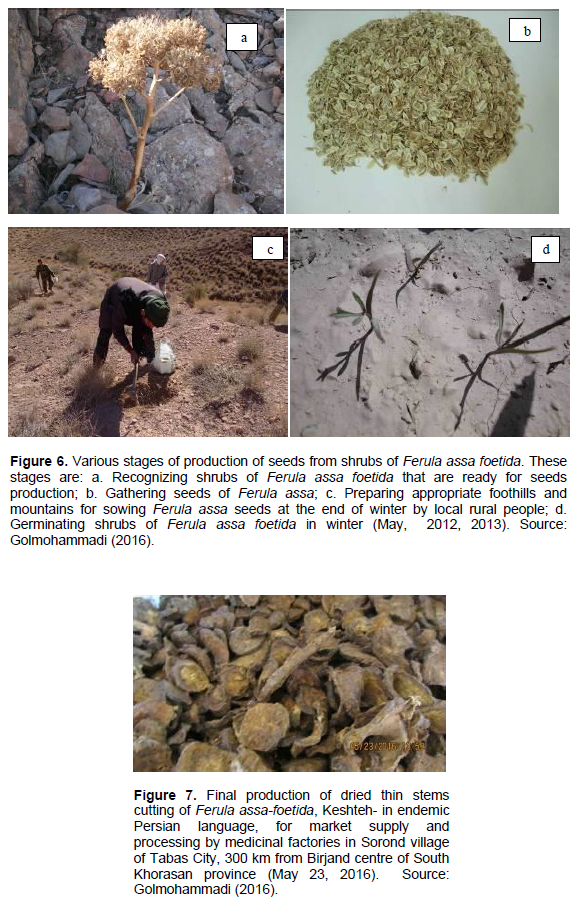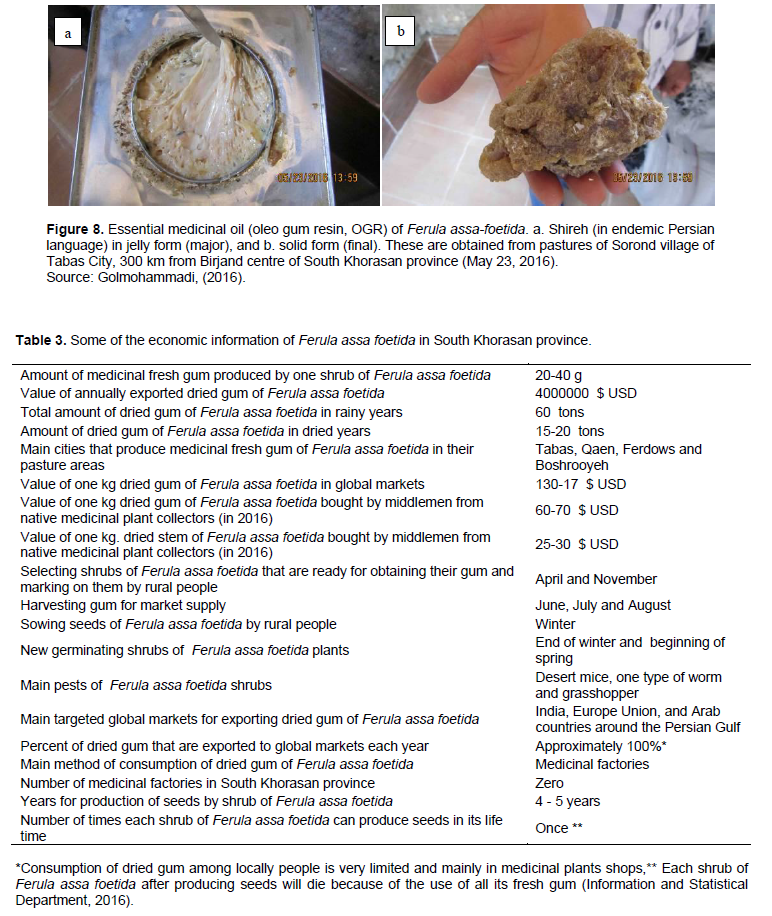Full Length Research Paper
ABSTRACT
Traditional knowledge is considered as knowledge, innovations, practices of indigenous and local communities embodying traditional life-styles; the wisdom developed over many generations, of holistic traditional scientific utilization of lands, natural resources and environment. Traditional knowledge is valid and necessary, and due to its relevance, it currently has wide application for human benefit. Many people in Mediterranean region who consult spiritual healers, homeopaths and herbalists are utilizing traditional therapies. These are the first choice for problems such as liver diseases, inflammation, skin diseases, infertility, impotence, diabetes, obesity, epilepsy, psychosomatic troubles and many other diseases. Ferula assa-foetida L. (Apiaceae) is one of the most important among the thirty species of Ferula distributed in Iran. One part used is an oleo-gum resin, called asa-foetida or anghoze in Persian, which is obtained by incision from the roots. Ferula is one of the most important endangered medicinal plants, which is rare in nature due to poor seed germination. In this article, qualitative and participatory study on main characteristics, harvesting and economic importance of this valuable medicinal plant in south-khorasan province, East of Iran, as a major producer and exporter, is introduced.
Key words: Ferula, traditional knowledge, medical plant, rural regions, Iran.
INTRODUCTION
Medicinal plants are an important element of the medical system. These resources are usually regarded as part of cultural traditional knowledge (Golmohammadi, 2013). The genus, Ferula belongs to the Umbelliferae family and consists of 140 species which are widespread from the Mediterranean region to central Asia. Ferula assa-foetida L. (Apiaceae) is one of the most important species of this genus which is native to Iran and Afghanistan, and commonly known as asa foetida. It is a herbaceous, monoecious and perennial plant that grows up to 2 m in height, and is in two types, bitter and sweet (Iranshahy and Iranshahi, 2011). F. assa-foetida L. (Apiaceae) is a medicinal plant indigenous to Iran and Afghanistan. This plant is one of the most important among the thirty species of Ferula distributed in Iran. One part used is an oleo-gum resin, called asa-foetida or anghouzeh in Persian, obtained by incision from the roots. It has been reported in Iranian folk medicine to be antispasmodic, aromatic, carminative, digestive, expectorant, laxative, sedative, nervine, analgesic, anthelmintic, aphrodisiac and antiseptic.
Asafoetida's English and scientific name is derived from the Persian word resin (asa) and Latin foetida, which refers to its strong sulfurous odour. Its pungent odour has resulted in it being called by many unpleasant names; in French it is known (among other names) as merde du diable (devil's faeces); in English, it is known as devil's dung, and equivalent names can be found in most Germanic languages (e.g. German Teufelsdreck, Swedish dyvelstr?ck, Dutch duivelsdrek, Afrikaans duiwelsdrek), also in Finnish, it is called pirunpaska or pirunpihka. In Turkish, it is known as ?eytantersi (devil's sweat), ?eytan boku (devil's crap) or ?eytanotu (the devil's herb) (Hassani et al., 2009) (Table 1).
Medicinal plant collectors are usually poor villagers. Plant collection is their part time activity besides farming and livestock keeping (Hamayun et al., 2003). This situation has also been seen in South Khorasan province, south east of Iran (Figure 1).

MATERIALS AND METHODS
The study area is South Khorasan province, east of Iran. The present study was conducted from 2010 to 2017 in rural regions of South Khorasan province, east of Iran (Figure 2). South Khorasan province consists of 11 counties namely: Birjand, Ferdows, Tabas, Qaen, Nehbandan, Darmian, Sarbisheh, Boshruyeh, Sarayan, Zirkouh and Khusf.
Two main regions in mountains and pastures where Ferula assa-foetida L. are grown are, Tabas and Darmian counties, thus majority of field research has been done in these locations. For this article, recent and most important articles in the domain of the research wereas utilized. main instruments for gathering information in this article were qualitative and participatory research methods and place-based approaches, using in-depth semistructured interviews and participatory observation, discussions, experiments, documents, pictures and nonformal interview with villagers, related officers, specialists and professors in the domain of this research from 2010 to 2017.
various stages for harvesting Ferula gum, plus producing and sowing its seeds
F. assa foetida grows up to 2 m high, with a circular mass of 30 to 40 cm leaves. Stem leaves have a wide sheathing petioles. Flowering stems are 2.5 to 3 m high and 10 cm thick and hollow, with a number of schizogenesis ducts in the cortex containing the resinous gum. Flowers are pale greenish yellow in color, produced in large compound umbels. Fruits are oval, flat, thin, reddish brown and have a milky juice. Roots are thick, massive and pulpy. They yield a resin similar to that of the stems. All parts of the plant have a distinctive fetid smell (Table 2).
Resin-like gum is obtained from the dried sap, extracted from the stem and roots and is used as a spice. The resin is grayish-white when fresh but dark amber in color when dry. The asa foetida resin is difficult to grate and is traditionally crushed between stones or with a hammer. Today, the most commonly available form is compounded asa foetida, a fine powder containing 30% asa foetida resin, together with rice flour and gum Arabic. F. assa foetida exudations are obtained by tapping the root stock of the plant.
The root of this plants have been used for perceived anthelmintic, antimicrobial, antispasmodic, aromatic, laxative, antispasmodic, diuretic and antiseptic actions in folk medicine. F. assa-foetida L. (Apiaceae) is one of the most important endangered medicinal plants, which is rare in nature due to poor seed germination. Although, the flora of Persia is thus fairly well known, there are still very few works on its overall vegetation (Information and Statistical Department, 2016; Golmohammadi, 2013). In this regard, various stages for harvesting and obtaining Ferula gum are as follows:
i. Selecting shrubs of F. assa Foetida which are ready for use as medicinal gum and marking them by rural people from April and November (Figure 3).
ii. Fencing these selected shrubs with stones (Figure 4).
iii. Harvesting gum; this is the final stage of producing dried gum, and supply to the market is done in June, July and August. In this stage, in every 4 to 5 days of these months, native medicinal plant collectors with their traditional tools (Figures 4 and 5) create a thin cutting on the stem and after this period, they gather resin-like gum discharges from the stem, which is again replicated with 12 to 16 rounds, each in 4 to 5 days on the stems of Ferula in these months (Figures 7 and 8). In gathering of the gum, before thin cutting of Ferula shrubs stems by native medicinal plant collectors with the above 12 to 16 rounds, they are collected and dried to obtain dried stem cutting of F. assa (Keshteh- in endemic Persian language), which will be taken to the market and processed by foreign medicinal factories (Figure 7 and Table 3). Each skillful native medicinal plant collector can in one day cut stems of 1000 Ferula shrubs and gather 4 to 10 g of resin-like gum from each stem cutting in 4 to 5 days. This means that a skillful native medicinal plant collector can obtain 2 to 3 kg gum from Ferula shrubs in dry and rainy seasons in the months of harvest (Figure 4).
iv. producing seeds from shrubs of F. assa foetida are set by the end of summer.
v. sowing seeds of F. assa foetida by rural people in winter and beginning a new germination of plant by the end of winter, originates a new spring (Figure 6) (Information and Statistical Department, 2016) (Table 3).





Essential oil of Ferula
Essential oils (volatile oils) are aromatic oily liquids obtained from plant materials such as flowers, herbs, buds, fruits, twigs, bark, seeds, wood, roots, resin, gum and latex. Essential oil components are chemically derived from terpenes and their oxygenated derivatives, which are aromatic and aliphatic acids, esters and phenolic compounds.
The percentage of components of the essential oils varies among species and plant parts, depending on the species, climate and altitude, time of collection and growth stage. the composition of essential oils might be different qualitatively and quantitatively.
F. assa-foetida is a herbaceous perennial plant with an unpleasant odour and is often considered to be the main source of oleo-gum-resin (OGR, a milky exudation from certain plants that coagulates on exposure to air), which has a characteristic sulfurous odour and bitter taste (Kavoosi and Rowshan, 2013). Oleo-gum resin is obtained as, secretions of the upper parts of the roots in plant by incision. It is a dark brown to black resin-like gum obtained from the juice of the rhizome. After drying, it becomes dark brown in color with resin-like mass. Different grades of resins, dried granules, chunks or powders are sold. It is marketed in three forms: tears, mass and pastes. Chemical composition and antibacterial activity of essential oils of commonly consumed herbs, such as Citrus aurantium, Citrus limon, Lavandula angustifolia, Matricaria chamomilla, Mentha piperita, Mentha spica, Ocimum basilicum, Origanum vulgare, Thymus vulgaris, Salvia officinalis and Zataria multiflora and their main components have been evaluated in many countries. The main constituent of OGR is essential oil which contains ferulic acid, sesquiterpene, sulfur-containing compounds, monoterpenes and other volatile terpenoids. Although, advances in chemical and pharmacological evaluation of F. assa-foetida have occurred in recent past, several useful features of this plant remains unknown (Kavoosi and Rowshan, 2013). Accordingly, essential oils obtained from F. assa-foetida OGRs in different collections had different chemical composition, antioxidant, reactive oxygen species (ROS), reactive nitrogen species (RNS), H2O2 and TBARS scavenging activities. The essential oil of OGR1 had high levels of acyclic sulfur-containing compounds [(E)-1-propenyl sec-butyl disulfide and (Z)-1-propenyl secbutyl disulfide] and bicyclic sesquiterpenes (10-epi-c-eudesmol) which showed the highest radical scavenging and the lowest antibacterial and antifungal activities.
Essential oil of OGR2 had high levels of acyclic sulfur-containing compounds [(Z)-1- propenyl sec-butyl disulfide and (E)-1-propenyl sec-butyl disulfide] and bicyclic monoterpenes (b-pinene and a-pinene) which showed moderate radical scavenging, antibacterial and antifungal activities. Essential oil of OGR3 had high levels of bicyclic monoterpenes (b-pinene and a-pinene) and heterocyclic disulfide (1, 2-dithiolane) which showed lowest radical scavenging and highest antibacterial and antifungal activities. For this reason, the essential oil obtained from the earlier stages of F. assa-foetida growth could be used as safe and effective natural antioxidants in food industry, to improve the oxidative stability of fatty foods during storage, while the essential oil obtained from the later stages of F. assa-foetida growth could be used in health industry, as a safe and effective source of antimicrobial agents. However, this is the first report on the effect of growth stage on the essential oil profile of F. assa-foetida. More professional studies are required to examine phenolic and flavonoid biosynthetic pathways and expression profiles of the related enzymes. With these expertise studies, tentative applications of essential oils can be discussed (Kavoosi and Rowshan, 2013).
Ferula and traditional medicine
In traditional medicine, this plant is used for the treatment of different diseases, such as asthma, epilepsy, stomachache, flatulence, intestinal parasites, weak digestion and influenza (Kavoosi and Rowshan, 2013).
The old traditional phytomedicine asafoetida, an oleo-gum-resin obtained from the roots of different F. assa-foetida, is used in different countries for various purposes. This oleo-gum-resin has been known to possess antifungal, anti-diabetic, anti-inflammatory, anti-mutagenic and antiviral activities. A wide range of chemical compounds including sugars, sesquiterpene coumarins and polysulfides have been isolated from this plant. Recent studies have shown new promising antiviral sesquiterpene coumarins from this old phytomedicine. Asa foetida has been used as a spice and a folk phytomedicine for centuries and has a characteristic sulfurous odor and a bitter taste. It is used as a flavoring spice in a variety of foods, particularly in India. In addition, Nepali people regularly consume it in their daily diets, and it is believed that asafoetida has aphrodisiac, sedative and diuretic properties.
Another biological activity of F. assa-foetida, which has been confirmed by a number of new studies, is cancer chemoprevention. Antihelminthic property (or anthelmintic) is another emphatically reported traditional use of asa foetida in different countries. In Iran, China and Nepal, it is traditionally used for the treatment of intestinal parasites infestation (Iranshahy and Iranshahi, 2011) and (Gundamaraju, 2013). According to the Chinese, European, Iranian and Indian traditional medicines, oleo gum resin of F. assa-foetida (asa foetida) has therapeutic effects on different kinds of diseases. Some of these effects are related to the diseases of nervous system such as hysteresis and convulsion (Moghadam et al., 2014).
DISCUSSION
The demand for medicinal plants has increased globally due to the resurgence of interest in and acceptance of herbal medicine. Most of the demand is being met through collection of large quantities of medicinal plants and plant parts from wild populations. The methods of extraction employed are almost invariably crude and unsystematic. As a consequence, the rates of exploitation may exceed those of local natural regeneration.
Water is a major natural resource which is a limiting factor in the development of agriculture and natural resources, especially in a dry region such as Iran. Therefore, it is necessary to adopt water management technologies for utilizing the available water resources. Water is the most precious commodity in the arid region of Iran due to prevalence of unfavorable hydro meteorological condition (Golmohammadi, 2012). We are living in a knowledge driven world where knowledge is the ultimate power (Kumari et al., 2014).
In this regard, indigenous traditional and local knowledge on medicinal plants are important elements of herbal and medicinal system. These resources are usually regarded as part of the cultural traditional knowledge. Despite all kinds of technological advances, the geographic variation is one element that is far from human control because of the different climatic conditions and edaphic factors that exist in each region.
Essential oil quality and quantity in general are extremely dependent on the weather conditions; also, several authors considered that the physico chemical characteristics are determinant factors in secondary metabolites composition especially for quality of volatiles (Moghaddam and Farhadi, 2015).
Also, the natural habitats are quickly being depleted. There is thus an urgent need to develop and implement conservation strategies to exploit medicinal plant species. The medicinal plant is propagated through seeds. However, its natural populations are very limited in native habitats, which may be due to poor seed germination. Low seed germination in Apiaceae is also known (Moghadam et al., 2014; Golmohammadi, 2012).
F. assa-foetida L. (Apiaceae) is one of the most important and valuable medicinal plants in pastures of Iran and especially, south-khorasan province with the majority of its products (about 99%) being exported to foreign countries (especially for utilizing by medicinal factories in developed countries). Because of the above reasons, main goals of managers of Natural Resources and Watershed Administration of south Khorasan province are sustainable exploitation plus maximum economic efficiency of this plant. Ferula is one of the most important endangered medicinal plants, which is rare in nature due to poor seed germination (Information and Statistical Department, 2016). The production of this valuable plant in south-khorasan province in about 100000 ha, is 60 (in rainy years) and 15 to 20 tons (in dried years) annually and almost all of this production is exported because of, lack of processing industries in this province. this plant generates income for many rural and nomadic households, which in the conditions of their subsistence agriculture, have high dependence on this production.
South khorasan province in the east of Iran has good ethnobotanical potential for medicinal plants. With the presence of the above mentioned cases, the author stated the following recommendations for sustainable management and exploitation with increased economic efficiency of this plant:
i. Utilizing F. assa-foetida in the present traditional form namely, cutting its stem from above its root for producing gum is not a sustainable way for exploitation because after one season, production of gum by mature plant in the next year will result in the death of the plant. In this regard, in the research centers of Natural Resources and Watershed organization of Iran, researchers have found methods for sustainable utilization of Ferula such as concave and staircase methods. These new, scientific and sustainable methods must be extended among farmers (especially by agriculture and natural resources extension workers), replacing the present prevailing hazardous traditional method.
reduction in the number of small (especially goats and sheep herds) and big livestocks (cow's herds in second order) is the major weakness in pastures of south khorasan province. Also, prevention from grazing by these livestock herds is mainly during germination and exploitation seasons of Ferula. In this regard, Natural Resources and Watershed organization of Iran must allow livestock grazing in these pastures only after the last exploitation stage of Ferula.
ii. Development of strategic planning for appropriate future exploitation-utilization of Ferula and other medicinal plants.
iii. Controlling exploitation stages and monitoring the quantity and quality of Ferula products.
iv. Conserving and restoring to life the germinating locals and pastures of Ferula.
v. Absorbing participation of local people in implementing Ferula plans and projects of Natural Resources and Watershed organization by strengthening the local organizations of medicinal plant collectors.
vi. Establishing factories in the field of medicinal plants especially, Ferula in the south khorasan province. This can create jobs for unemployed local youth, preventing them from raw and cheap selling and exporting of Ferula gum and increasing its final value. This is also an important step for accessing sustainable development and poverty alleviation goals, and criteria in this deprived, dried and remote region of Iran.
CONFLICT OF INTERESTS
The author has not declared any conflict of interests.
REFERENCES
|
Golmohammadi F (2016). Certification for scientific collaboration and scientific field participation in Medical plant of Ferula assa Foetida-with research team from: General Director, Mangyshlak Experimantal, Botanical Garden, Candidate of Biology Science, Akzhunis Imanbayeva, Aktau, Kazakhstan. Belonged to Ministries of Education and science of the Republic of Kazakhstan. |
|
|
Golmohammadi F (2012). Sustainable agriculture and rural development in Iran, Some modern issues in sustainable agriculture and rural development in Iran. LAP Lambert Academic Publishing Germany. |
|
|
Golmohammadi F (2013). Medical plant of Ferula assa-foetida and its cultivating, main characteristics and economical importance in South khorasan province - east of Iran. Technical Journal of Engineering and Applied Sciences 3(18):2334-2346. |
|
|
Gundamaraju R (2013). Evaluation of anti-helmintic activity of Ferula foetida "Hing- A natural Indian spice" aqueous extract. Asian Pacific Journal of Tropical Disease 3(3):189-191. |
|
|
Information and Statistical Department (2016). Annually Reports of Natural Resources and Watershed Organization of South Khorasan province, Iran. |
|
|
Iranshahy M, Iranshahi M (2011). Traditional uses, phytochemistry and pharmacology of asafoetida (Ferula assa-foetida oleo-gum-resin)-A review. Journal of Ethnopharmacology 134(1):1-10. |
|
|
Kavoosi G, Rowshan V (2013). Chemical composition, antioxidant and antimicrobial activities of essential oil obtained from Ferula assa-foetida oleo-gum-resin: Effect of collection time. Food Chemistry 138:2180-2187. |
|
|
Kumari NC, Choudhary SB, Jha SK, Singh SRK (2014). Radio: An educational media to transfer agricultural information among farmers. Indian Research Journal of Extension Education 14(2):130-132. |
|
|
Moghadam FH, Dehghan M, Zarepur E, Dehlavi R, Ghasemini F, Ehsani S, Barzegar K (2014). Oleo gum resin of Ferula assa-foetida L. ameliorates peripheral neuropathy in mice. Journal of Ethnopharmacology 154(1):183-189. |
|
|
Moghaddam M, Farhadi N (2015). Influence of environmental and genetic factors on resin yield, essential oil content and chemical composition of Ferula assa-foetida L. populations. Journal of Applied Research on Medicinal and Aromatic Plants 2(3):69-76. |
|
Copyright © 2024 Author(s) retain the copyright of this article.
This article is published under the terms of the Creative Commons Attribution License 4.0